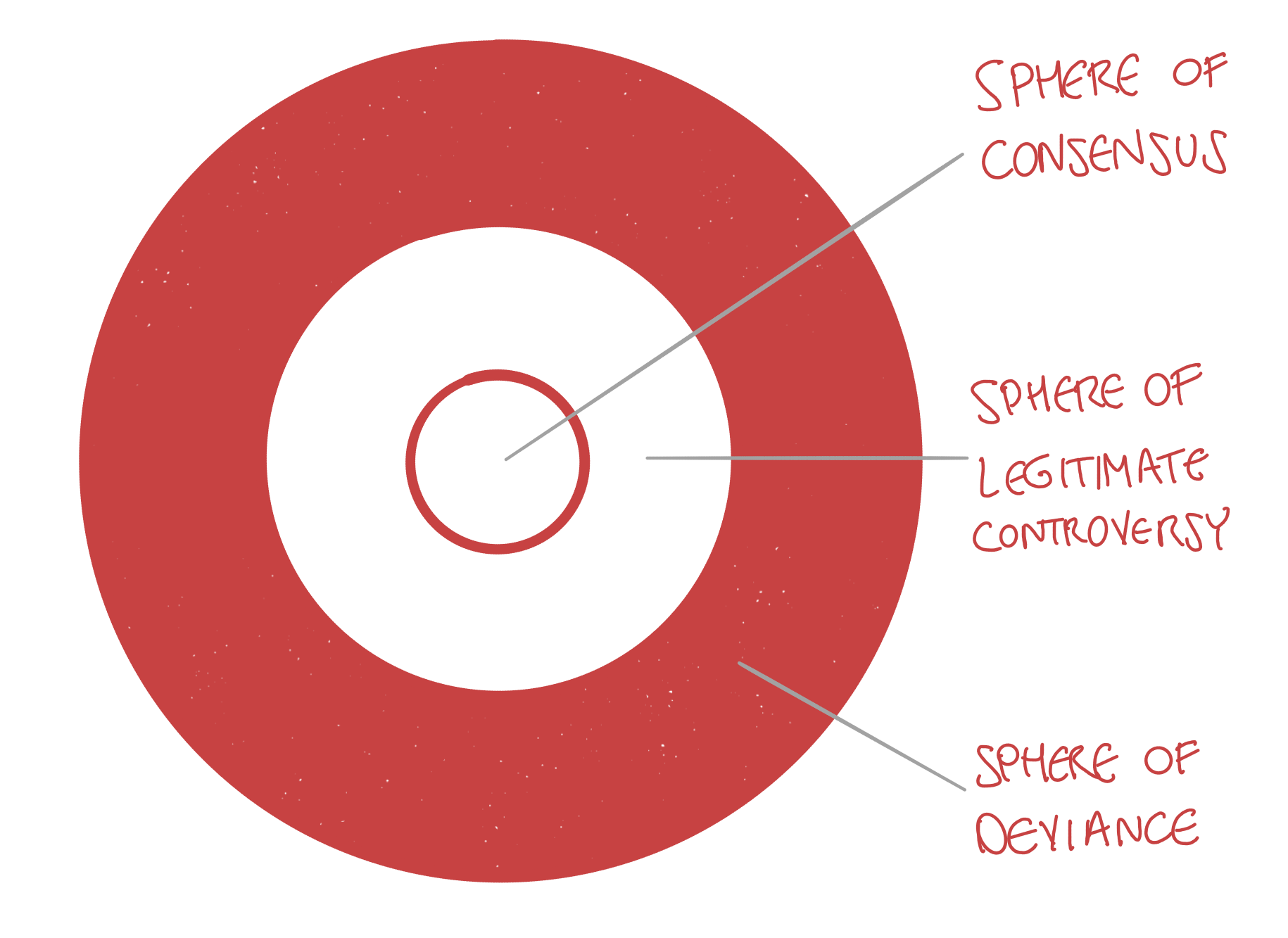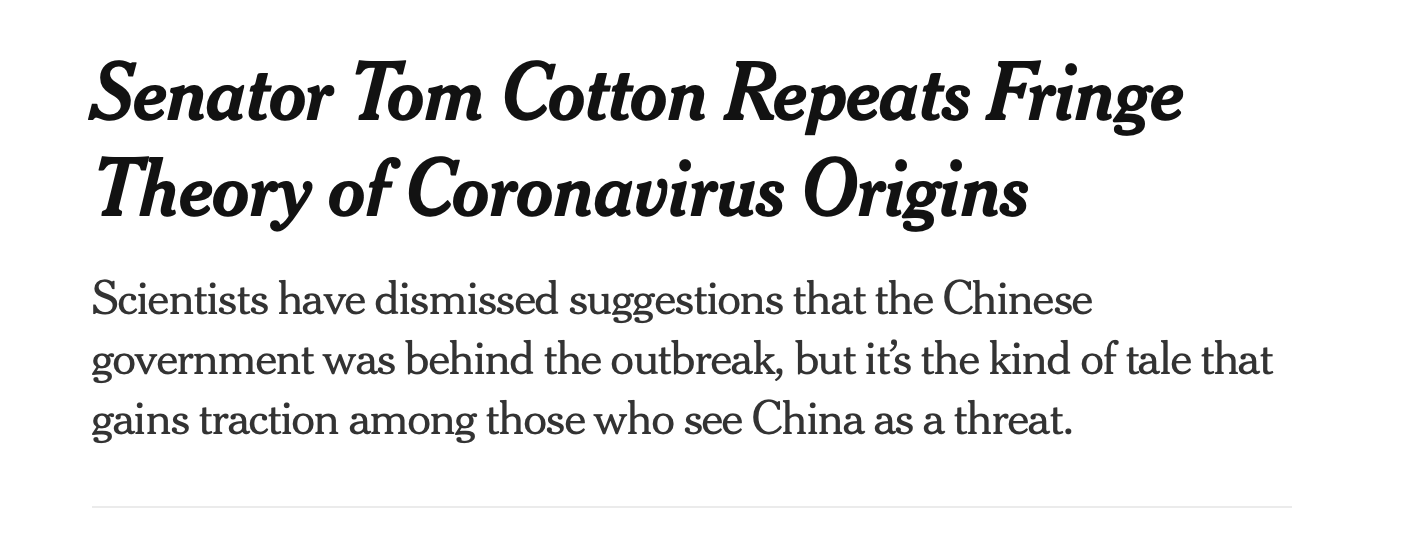Two stories this week are worth looking at more deeply, for our purposes as activist citizens. And they’re both around COVID.
So, a disclaimer first. I’m not advocating here for any particular theory or treatment; I have neither the information nor the expertise to do so. But I am curious about what these stories mean: for the debate on the pandemic, for how narratives shift, and for online activism in general.
OK, let's go.
The spheres model
The concept of Hallin’s Spheres shows how the media legitimises or delegitimises ideas.

According to the model1, ideas in the Deviance sphere we “feel authorised to treat as marginal, laughable, dangerous”. You know which I mean: flat-Earth theories, UFOs, QAnon. Maybe homeopathy. And the paranoid, outlandish notion that our governments are (uh) spying on us.
Now as we know, COVID is a stress test for the systems we’ve built to sustain our way of life – our information ecosystem included. And in a short time, the debate around COVID has given us the chance to see two ideas move through Hallin’s spheres like never before.
Case 1: It all started with a leak
The hypothesis that the COVID virus escaped from a lab, rather than occurring naturally, was considered a fringe conspiracy theory for much of 2020. When US senator Tom Cotton — a vocal Trump supporter — suggested at the start of the year that the theory was plausible, two of the country's most influential media outlets dismissed it as nonsense:


With ‘serious’ media on board, the narrative gained acceptance. Trump and his senior officials then put forward the Lab Leak theory themselves. The Establishment media, opposing Trump, dug in; the narrative hardened. And within a few weeks, in polite circles if you suggested COVID had been cooked up in a lab, you’d be considered a gullible, alt-right loon.
The idea was widely seen as marginal, laughable, even dangerous.
The 180-degree turn
Fast-forward to June 1, 2021, though, and all serious media outlets have reversed their positions on this story. The WaPo and the NYT have issued corrections, while the Wall Street Journal said the theory could be true. And even Jon Stewart has bounced around on national television declaring it OK to talk about the Lab Leak theory.
What happened in a year? The facts on the ground shifted, and Trump was voted out. So it became possible for the media to entertain the Lab Leak theory again.
In his post-mortem of this media failure, Matt Iglesias posits:
This is a case of a smallish group of reporters and fact-checkers proclaiming a scientific consensus where none ever really existed.
And as a leading scientist involved in the debacle now admits:
It was scarier to be associated with Trump and to become a tool for racists, so people didn’t want to publicly call for an investigation into lab origins”
Watch the Jon Stewart video again. Listen to the awkward laughs when Stewart starts to go all-in on the Lab Leak Theory, and the uncomfortable reaction of the host, Stephen Colbert.
These are the signs of the theory puncturing Hallin’s Sphere of Deviance, and bursting into the zone of Legitimate Controversy.
Case 2: “Populist” medicine
In the Lab Leak case, the media scoffed at the idea and discounted it.
But the story of Ivermectin is more egregious. Here, information gatekeepers engaged in outright censorship.
This week, Matt Taibbi covered the story of Dr. Pierre Kory. Kory has pioneered therapies that are now the standard of care or COVID-19 patients (read: he's Not Fringe).
In December, Kory testified to the US Senate that the widely-used anti-parasite drug Ivermectin was proving to be an effective therapy against COVID, and deserved further research. Eight million people watched it.
But then, Taibbi writes,
YouTube, in what appears to be a first, removed video of the hearing, as even Senate testimony was now deemed too dangerous for public consumption. YouTube later suspended the Wisconsin Senator who’d invited Kory to the hearing, and when Kory went on podcasts to tell his story, YouTube took down those videos, too. Kory was like a ghost who floated through the Internet, leaving suspensions and blackened warning screens everywhere he went.
And today, LinkedIn is also on the case, apparently censoring discussion of Ivermectin as a potential treatment:
Linked In have just told Dr Tess Lawrie, one of the top 5% medical analysts in the country, her published review on #ivermectin goes against their policies. So Linked In, your unqualified book burning policy is to ban free speech and expert medical analysis that saves lives. pic.twitter.com/g23FmGbCD8
— Ian Harper (@IanHarper58) June 22, 2021
At the same time, a new peer-reviewed study in the American Journal of Therapeutics suggests that large reductions in COVID-19 deaths are possible using Ivermectin.
Ivermectin may never be proven as an effective therapy for COVID. But with giants of medicine behind it, and so many lives at stake – especially in poorer countries – it at least warrants discussion. Not censorship.
And that discussion slowly seems to be happening. That rumble you hear is the Ivermectin hypothesis, burrowing its way towards the Legitimate Controversy sphere.
WTF?
Scientific discoveries are a moving target. Yesterday’s batshit crazy ideas could be tomorrow’s consensus, as Hallin’s model shows.
But the media outlets and social media corporations in these two cases didn’t say ‘we don’t yet have enough information to know the truth’. They shut down the debate: with sneering dismissal in the first case (with a helping of smear). And shameless censorship in the second. What’s going on?
We don’t have to entertain any conspiracy theories of our own to get pointers. We're witnessing how the Establishment strives to keep a lock on which ideas remain in which spheres. To quote Noam Chomsky, they:
strictly limit the spectrum of acceptable opinion, but allow very lively debate within that spectrum
At a time when the world was in a panic about how to grapple with COVID, Silicon Valley and Establishment media waged a full-on campaign against medical ‘misinformation’. The goal was worthy, but the means were extreme. As Taibbi writes (emphasis mine):
Once envisioned as a vast democratizing tool, which would massively raise global knowledge levels by allowing instant cross-global communication between all people, [the Internet] morphed instead into a giant unaccountable bureaucracy for suppressing dialogue, run by people with an authoritarian vision for information flow.
Lab Leak and Ivermectin were deviant ideas, seen by the 'giant unaccountable bureaucracy' as too radical to be contemplated or discussed. That the COVID debate broke along political lines, in a sharply polarised country and during an election year, all but sealed the fate of these important theories. Until everything changed.
As activist citizens, hunting for truth, we need to figure out where the limits of Hallin’s spheres lie. To learn who is keeping what ideas in which sphere, and why. To call these powers out when they are playing dirty.
And to do our part to push ideas between the spheres to achieve our goals.
Update 24/06/21: Joe Rogan has a new 'emergency podcast episode' on Ivermectin. And Oxford University has announced they will study the drug in a large-scale trial.
Notes
1: OK, the model is more complex in reality, as the content of the spheres shifts depending on the media landscape you're looking at, and other factors. But for us here, I think it fits.


